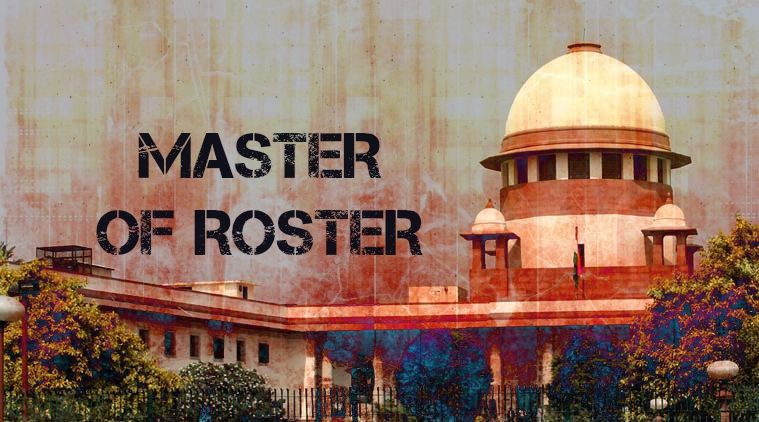In the last few months, the Country witnessed a heated debate on ‘Master of Roster’ both on the political as well as judicial sides. Though, on the judicial side there has been several judgments of the High Courts and the Supreme Court interpreting the correct positions of ‘Master of Roster’, the recent debate all started with celebrated public interest lawyer Prashant Bhushan filing a petition in the Supreme Court in the Judges bribery case and asking the Chief Justice of India to recuse in the matter, to which he refused. Later on, the unprecedented Press conference by the four senior-most judges of the Supreme Court made this episode more sordid. The four judges impliedly hinted that there had been an arbitrary allocation of politically sensitive cases to some select benches by the Chief Justice of India. Even after the Supreme Court making it clear in its recent three judgments about the correct position of ‘Master of Roster’ the political as well as legal fraternity still appear to be divided on the issue. Let us understand what it means to be the ‘Master of Roster.’
The Oxford Dictionary defines ‘Roster’ as ‘a list of people’s names and the jobs they have to do at a particular time.’ Thus, simply speaking, ‘Master of Roster’ becomes ‘A man who decides such list.’ Therefore, the ‘Master of Roster’ can mean to refer to a person who decides and distributes the works to his colleagues.
Master of Roster: In the Indian Legal Context
In the Indian legal context, the ‘Master of Roster’ refers to the administrative power of the Chief Justice of India and the Chief Justices of the High Courts to allocate the matters that their brother and sister judges shall be hearing, respectively. It means that the Chief Justice of India has this exclusive administrative authority to decide the allocation of cases brought or pending before the Supreme Court to his/her fellow judges. The same authority extends to the Chief Justices of the High Courts. No, other puisne judges have any say in this matter, as per the established convention. When the Chief Justice of India and the Chief Justices of the High Courts decide the roster or allocation of cases to their puisne judges or Benches, they do so under the administrative authority entrusted to them. In crux, a roster declares what work is assigned to High Court and Supreme Court judges. ‘Master of the Roster’ refers to the privilege of the Chief Justice to constitute Benches to hear cases. Therefore, the Chief Justice of India and the Chief Justices of the High Courts enjoy and exercise both, the judicial as well as the administrative power. But, this is to be made clear that being ‘Master of Roster’ doesn’t give the Chief Justice of India or the Chief Justices of the High Courts, any superior authority over puisne judges. The Chief Justice is just first among the equals.
Master of Roster: The Legal Genesis
A significant portion of the Indian Constitution is derived from the ‘Government of India Act, 1935’. This Act, through its section 214(3) prescribed in relation to the then Federal Court of India, that “Subject to the provisions of any rules of court, the Chief Justice of India shall determine what judges are to constitute any division of the court and what judges are to sit for any purpose.”. The Federal Court of India had been constituted under the ‘Government of India Act, 1935’ and continued to function until the Supreme Court of India was established in 1950. Thus, the Supreme Court of India is a successor institution of the Federal Court of India. Therefore, the said provision of the then ‘Government of India Act, 1935’ has been accepted as a sound convention for the smooth functioning of the Superior Courts, though there is no similar provision in the Constitution of India. However, Article 145 of the Indian Constitution provides power to the Supreme Court to frame its own rules to regulate the practice and procedure of the Court.
Master of Roster: The USA, UK, and Japan
The Supreme Court of the United States sits and hear the matters en banc. This means that all the nine judges of the Supreme Court of the United States sit together to hear a case, with the circumstantial exception of a judge being ill or if he decides to recuses himself from the matter. This leaves no discretion for the Chief Justice to decide the allocation of judicial hearings.
In the United Kingdom, the position is something different. There are a total number of 12 judges in the UK’s Supreme Court, and they often sit in the panel of five that ultimately leaves minimal discretion for the Chief Justice to decide the roster. Here also, the Court may sit en banc in case of matters concerning great Constitutional and public importance, or where the Court is being asked to depart from its earlier decision, etc.
In Japan, the number of judges in its Supreme Court is 15 that generally sits in the panel of five judges. This again leaves a constrained space for the Chief Justice to decide the matters to be heard by his puisne judges. The Court may sit en banc if a matter of Constitutional importance is to be decided or if a previous decision of the Supreme Court is to be overturned.
The Peculiarity in Indian Context
The necessity of constituting different benches in India arises from the fact that the Indian Supreme Court or even the High Courts, hear a vast number of cases annually, unlike the Supreme Court of these developed Countries. As per the latest data made available on the Supreme Court’s official website, the total number of pending cases in the Indian Supreme Court is 54,013, as on 4th of May 2018. As on February 4, 2018, around 4.2 million cases are pending before 24 High Courts in India. If you compare these figures with the United States, the Justices there decide which cases to be heard, and on an annual basis they hear about 80 cases only, and they decide another 50 without hearing arguments, although they receive around 7000 requests to hear cases each year. The most of the cases they chose to hear constitutes the matters of Constitutional importance or relating to the Federal law. But, in our Country, this is not the case. Here, THE Supreme Court and the High Courts hear a range of diverse matters on a daily basis. The advent of the concept of PIL has made the list of pendency longer. Therefore, this peculiarity of the excessive pendency of cases in India necessitates the constitution of several benches to decide the matters fast, and therefore the importance of ‘Master of Roster’ is significantly higher in Indian context than any other judicial systems of the world.
Stay tuned for the next part of ‘Master of Roster’.
Further; Read More:
Vaibhav Raut’s arrest: a battery of questions to the scrappy affair of Maha ATS
Moment of silent contemplation for Jairam Ramesh; He befriended the lobby of urban Maoists?



